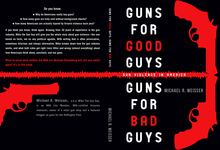 The National Shooting Sports Foundation has been running an anti-gun trafficking campaign for many years called, Don’t Lie For the Other Guy. The campaign reminds gun owners that it’s a federal crime to go into a gun shop, lie on the background check form and then give the gun you’ve purchased to someone else who can’t purchase the gun themselves. Most gun shop owners proudly display a campaign poster like the one in this blog, and just about every gun shop owner does a good job in supporting the campaign.
The National Shooting Sports Foundation has been running an anti-gun trafficking campaign for many years called, Don’t Lie For the Other Guy. The campaign reminds gun owners that it’s a federal crime to go into a gun shop, lie on the background check form and then give the gun you’ve purchased to someone else who can’t purchase the gun themselves. Most gun shop owners proudly display a campaign poster like the one in this blog, and just about every gun shop owner does a good job in supporting the campaign.
But in the wake of the Navy Yard shooting this campaign has taken on a new twist because one after another, NRA sympathizers and NRA-based pundits are lying like hell for the other guy, in this case, the NRA. What are they lying about? The alleged cause-and-effect between shootings and the existence of “gun free” zones. This first became the NRA mantra after Newtown, when LaPierre called for a replacement of gun-free zones in schools with armed guards, a statement he repeated after the Navy Yard. Now we have the same nonsense being promoted in the wake of Navy Yard shooting that took place on a military installation which was “de-gunned” by an Executive Order issued by President Clinton in 1993 (although the policy had been in force at many military bases unofficially under George Bush I.)
The latest version of the lie was produced last week by none other than John Lott, whose book on gun violence was based on data that he couldn’t actually produce, so I guess we can say that he probably doesn’t know when he’s lying or not. In any case, he went on a TV talk show and said the following about mass shootings in ‘gun-free’ zones: “With few exceptions, they’ve occurred where guns have been banned.” He repeated the same comments in a Fox News blog.
He’s wrong. The FBI data on mass shootings (4 or more victims) clearly shows that two-thirds of all mass shootings occur exactly the same place where all homicides occur - at or directly nearby the home of the victim. What a surprise, that the location of mass shootings is basically the same as the location of all shootings. But since most gun homicides start off as drug-related crimes or domestic arguments, where else are they going to take place? In a school?
Maybe John Lott’s not lying for the NRA. Maybe he hasn’t looked at the Uniform Crime Reports. After all, he only touts himself as a leading expert on gun violence. And once you’re a self-declared expert you don’t need to look at anything. All you have to do is keep shooting your mouth off (pardon the pun.) But if Lott doesn’t know this data he doesn’t even deserve amateur status in the argument about guns. if he does know the data, then he’s just lying for the other guy.
Related articles
- Piers Morgan Goes OFF on Pro-Gun Panel After Navy Yard Shooting (thehollywoodgossip.com)
- Obama admin borrows a page from the NRA, funding cops in schools (politicalticker.blogs.cnn.com)


Recent Comments